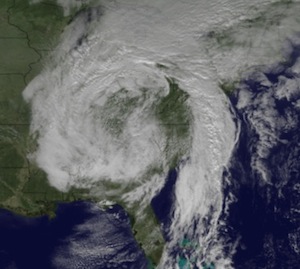Fifty-two billion dollars and counting, one thousand deaths — double the yearly average — from 12 extreme weather events in 2011 alone.
Those grim numbers are part of the reason why the country’s top weather official is calling for better and smarter observation tools, new climate models and a new national readiness.National Oceanic and Atmospheric Administration (NOAA) Administrator Jane Lubchenco shared those stats with scientists here at the American Geophysicial Union’s fall meeting in San Francisco (#AGU11), many of whom are giving presentations about how to better forecast these events and measure them.”
I think that people have to appreciate how very bizarre the weather has been this year,” Lubchenco told us in an interview following her keynote presentation. “And it’s pretty clear that for some of those events like heat waves, droughts, really big intensive rainfall events – those we can connect the dots to climate change pretty convincingly.”
Lubchenco showed the hall NOAA’s Extreme Climate Index that takes in highs and lows of heat and cold, rain, drought and hurricanes that made landfall from 1920 to 2011. While the index has been high in the past, the change from 1970 on is “quite pronounced and qualitatively different” from previous years, said Lubchenco.
[module align=”left” width=”half” type=”pull-quote”]”…heat waves, droughts, really big intensive rainfall events – those we can connect the dots to climate change pretty convincingly.”[/module]
She also quoted Munich Reinsurance Company, which says the frequency of extreme events has risen steadily over the past 20 years, tripling during that period. It’s one of the reasons why the insurance company now offers climate change micro insurance to farmers in the Caribbean, and why companies here in the States are struggling to recalculate their risks.
Lubchenco tossed out to the crowd two more stats from the United Nations and the White House Office of Science and Technology, which both say it is “very likely” that large-scale changes in climate are influencing extreme weather events. Plus, all ten indicators on the American Meteorological Association’s climate scale along with NOAA’s own National Climate Data Center show changes consistent with a warming climate.
Lubchenco would like to see the country develop what she calls “critical environmental Intelligence:” better and broader climate information and more finely tuned weather warnings that can be used by citizens, emergency managers and businesses. It’s already happening to some extent: New York City is using NOAA’s Digital Coast tool for flooding and sea level rise to revamp its infrastructure in Manhattan, for example.
She ended her address with a forecast of “increased overall warming, an amplified water cycle, more extreme events and more variability, more wild weather and wild swings in weather,” and a plea to keep budgets intact to monitor all of this.
“I can tell you that I think the road ahead in fraught with great uncertainty,” she told the gathering. “Observing systems, research, high-performance computing are all absolute prerequisites to producing weather and climate forecasts and all of these are at great risk. We need to make sure the current economic and political landscapes don’t erode our abilities to provide accurate reliable forecasts.”
2 thoughts on “NOAA Chief Wants Nation “Weather-Ready” for More Extreme Events”
Comments are closed.



More talk and no action to get at the source of the problem — geoengineering, solar radiation management, chem trails and playing God with science. How much money goes to CAUSING weather modification programs with no accountabilty, no authority to pollute the sky and no accessibility to know what is going on by the public….see Naomi Klein address at the TED conference about the RISKS being taken by the corporations involved. See the doc What in the World Are They Spraying…. http://www.geoengineeringwatch.org and http://www.californiaskywatch.com and http://www.coalition againstgeoengineering.org. Julie, a concerned citizen watching Frankensky!
More reinforcement of global warming (probably partly cotributed to by manmade activity) which is confirmed by a National Geographic article several years ago that plotted carbon emissions with average global temperature rise from 1860 to present. They matched almost identically on rise. What does it take to wake us up?!